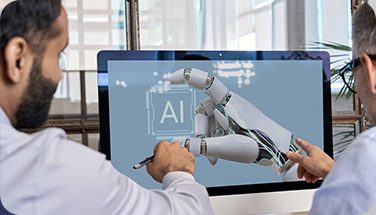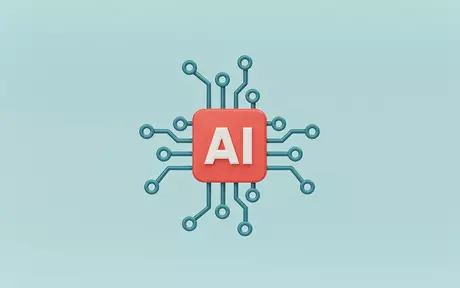10 steps to utilize generative AI in your ERP system
One emerging trend catching the attention of CIOs is generative AI, a form of artificial intelligence that uses Large Language Models to generate new content and ideas.
AI presents a solution to many different issues - when aligned to ERP, AI can work with employees to make their day-to-day processes more efficient and give back employees time that could be lost on repetitive and low-value tasks.

This blog explores generative AI and gives you 10 steps on how CIOs can prepare their ERP for generative AI integration.
Potential of generative AI in ERP
Generative AI can significantly enhance productivity by automating repetitive tasks and freeing up valuable time for employees to focus on more strategic initiatives.
Generative AI can improve efficiency by quickly analyzing and processing data, leading to faster and more informed decision-making. With machine learning, AI can train itself on the continuous stream of data that is input from your ERP, and eventually make these processes even faster.
Modern AI integrates into key business functions, streamlining HR tasks, facilitating data consolidation, and providing advanced reporting for Finance, as well as supporting strategic decisions on an executive level with data visualization and more.
AI within ERP can enable normal employees of any discipline to become citizen developers. Simple AI tools like text-to-code bots allow strings of text, such as ‘run a monthly credit check on customer X’ to complete manual and recurring tasks easily and quickly. Similar programs can generate content in seconds, where use cases are clear.
Generative AI further enhances ERP extensibility can also create extensibility in your ERP by enabling citizen developers to innovate bespoke solutions easily, without any coding ability. Employees can address issues on the fly and extend their systems using simple typed commands and natural language, offering a powerful asset for CIOs.
Click to read Top 9 CIO Considerations (Gated)
The use case for generative AI
However, CIOs should take a pragmatic approach to innovations such as Generative AI when facing a problem that can’t be solved easily through manual efforts. By acknowledging and respecting the limitations of AI, CIOs can make better decisions and successfully integrate AI into their organizations.
While automation is useful, AI can utilize current teams to their optimal productivity levels where talent gaps and shortages exist. A recent study from Korn Ferry on talent shortages suggests that “the biggest issue isn’t that robots are taking all the jobs—it’s that there aren’t enough humans to take them.”
Where current teams are struggling to find time for strategic tasks, AI can liberate them to refocus on tasks where human logic is required and reduce the amount of time spent on repetitive tasks that drain their energy.
Considerations for the implementation of generative AI
CIOs must take specific steps to prepare their ERP system to fully leverage the power of generative AI and ensure a smooth and successful integration.
Firstly, they need to assess their current systems and identify gaps or limitations that may hinder the integration of generative AI. This could involve evaluating their ERP's infrastructure, data management capabilities, and scalability.
Investment in training and upskilling teams is key to ensuring current talent is comfortable with AI. CIOs need to be sure employees are comfortable with AI, have the relevant skills, and are reassured that AI isn’t a replacement for them but a tool to make their day-to-day operations easier and more effective.
One of the main obstacles is the need for high-quality data. Generative AI algorithms require a large and diverse dataset to learn from, so it's crucial to ensure your ERP system has access to clean and reliable data.
10 steps to utilize generative AI in your ERP system
Like any technology, AI needs clear use cases and proper onboarding and implementation to ensure that new technologies align with corporate strategy and see a return on investment.
Here are our 10 steps to prepare your ERP:
1. Establish a foundation
- Lay the groundwork for future innovation by establishing a consistent data platform within your ERP system.
- Create a robust foundation that seamlessly supports the integration and deployment of generative AI technologies.
2. Ensure data quality and accuracy
- Ensure data accuracy and integrity across your organization, providing a reliable and clean dataset for leveraging generative AI models.
- Improve decision-making processes by relying on high-quality, consistent data accessible through your ERP system.
3. Unite key business functions
- Break down data silos by integrating various business processes into a unified platform, fostering collaboration and information flow.
- Streamline workflows and enhance efficiency by consolidating data sources, allowing generative AI models to leverage a comprehensive dataset.
4. Optimize resource utilization
- Increase resource efficiency by eliminating redundant data storage and optimizing data management processes within your ERP system.
- Ensure that resources are allocated effectively, providing ample computational power for generative AI applications.
5. Embrace agile processes
- Establish a flexible and scalable data platform that can easily adapt to changing business requirements and emerging technologies like generative AI.
- Position your organization to quickly adopt and integrate new AI capabilities without major disruptions to existing processes.
6. Facilitate advanced analytics
- Enable advanced analytics capabilities by centralizing data within the ERP system, providing a unified view for analytical tools and generative AI models.
- Drive data-driven insights and uncover hidden patterns that can inform strategic decision-making.
7. Ensure security and compliance
- Strengthen data security and compliance measures by consolidating data management within the ERP platform.
- Ensure that generative AI processes adhere to regulatory standards and data privacy requirements.
8. Deliver cost savings through integration
- Realize cost savings by reducing the complexity of managing disparate data sources and applications.
- Capitalize on the efficiency gains from integrated systems to drive cost-effectiveness throughout the organization.
9. Future-proof your technology stack
- Position your organization for the future by embracing a consistent data platform compatible with emerging technologies, including generative AI.
- Stay ahead of the technological curve and be prepared for the next wave of innovation.
10. Drive strategic competitive advantage
- Gain a strategic edge over competitors by leveraging generative AI on a foundation of consistent and integrated data.
- Enhance your organization's ability to innovate, respond to market changes, and stay ahead in a rapidly evolving business landscape.
How Unit4 can help you embrace generative AI
Generative AI can bring a large amount of value when use cases are succinctly identified and employee uptake of the tools are high. Generative AI can take your ERP platform next level and extend its capabilities hugely. However, CIOs must align with employees on the implementation of AI and ensure that use cases are clear.
Unit4 has multiple AI capabilities built into our Cloud platform, book a demo today and discover where AI can be used in your organization. To learn more about Unit4’s ERP solution and its AI capabilities talk to your account manager or consult the website to find more information.





